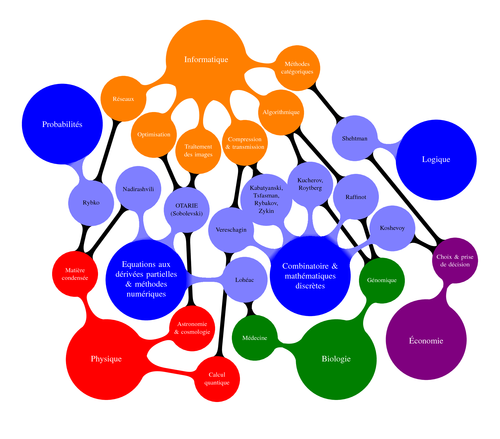Map of scientific interactions of researchers affiliated in 2008 to the J.-V. Poncelet laboratory (UMI 2615 CNRS, http://www.poncelet.ru)

Edit and compile if you like:
%%%%%%%%%%%%%%%%%%%%%%%%%%%%%%%%%%%%%%%%%%%%%%%%%%%%%%%%%%%%%%%%%%%%%%%%
% Author : Andrei Sobolevski (April 2009)
% License : Creative Commons attribution license
% Title : Map of scientific interactions of researchers
% affiliated in 2008 to the J.-V. Poncelet laboratory
% (UMI 2615 CNRS, http://www.poncelet.ru)
% Notes : Produced for the 2008 annual report of the lab;
% layout of subnodes is a result of manual optimization
% Tags : mindmap, layers
% Submitted to TeXample.net on 16 January 2010
\documentclass{article}
\usepackage{tikz,times}
\usepackage[paperwidth=25cm,paperheight=22cm,left=1cm,top=1cm]{geometry}
\usetikzlibrary{mindmap,backgrounds}
\pagestyle{empty}
\begin{document}
\centering\begin{tikzpicture}[mindmap,
level 1 concept/.append style={level distance=130,sibling angle=30},
extra concept/.append style={color=blue!50,text=black}]
% Applied area: computer science and its subfields
\begin{scope}[mindmap, concept color=orange, text=white]
\node [concept] {Informatique}[clockwise from=-5]
child {node [concept] (log) {M{\'e}thodes cat{\'e}goriques}}
child {node [concept] (alg) {Algorithmique}}
child {node [concept] (cod) {Compression \& transmission}}
child {node [concept] (img) {Tra{\^i}tement des images}}
child {node [concept] (opt) {Optimisation}}
child {node [concept] (res) {R{\'e}seaux}};
\end{scope}
% Applied area: theoretical physics and its subfields
\begin{scope}[mindmap, concept color=red,text=white]
\node [concept] at (-5,-15) {Physique}
child [grow=-10, level distance=160]
{node [concept] (qin) {Calcul quantique}}
child [grow=20]
{node [concept] (csm) {Astronomie \& cosmologie}}
child [grow=110]
{node [concept] (mat) {Mati{\`e}re condens{\'e}e}};
\end{scope}
% Applied area: biology and its subfields
\begin{scope}[mindmap, concept color=green!50!black,text=white]
\node [concept] at (6.5,-15) {Biologie}
child [grow=165, level distance=120]
{node [concept] (med) {M{\'e}decine}}
child [grow=60]
{node [concept] (gen) {G{\'e}nomique}};
\end{scope}
% Applied area: economics (one subfield)
\begin{scope}[mindmap, concept color=violet, text=white]
\node [concept] at (11,-14) {{\'E}conomie}
child [grow=70, level distance=120]
{node [concept] (dec) {Choix \& prise de d{\'e}cision}};
\end{scope}
% Researchers listed by their main specialization in mathematics
\begin{scope}[mindmap, concept color=blue]
% Combinatorics and discrete mathematics
\node [concept, text=white] at (5.2,-10.8)
{Combinatoire \& math{\'e}matiques discr{\`e}tes}
[clockwise from=150]
child [concept color=blue!50] {node [concept] (ver) {Vereschagin}}
child [concept color=blue!50, level distance=125]
{node [concept] (kab) {Kabatyanski, Tsfasman, Rybakov, Zykin}}
child [concept color=blue!50]
{node [concept] (kch) {Kucherov, Roytberg}}
child [concept color=blue!50] {node [concept] (raf) {Raffinot}}
child [concept color=blue!50, level distance=135]
{node [concept] (ksh) {Koshevoy}};
% Partial differential equations
\node [concept, text=white] at (-3,-11)
{Equations aux d{\'e}riv{\'e}es partielles
\& m{\'e}thodes num{\'e}riques}
child [concept color=blue!50, grow=0, level distance=140]
{node [concept] (lhc) {Loh{\'e}ac}}
child [concept color=blue!50, grow=60, level distance=115]
{node [concept] (otr) {OTARIE (Sobolevski)}}
child [concept color=blue!50, grow=95] {node [concept] (ndr)
{Nadirashvili}};
% Probability
\node [concept, text=white] at (-7.2,-3.2) {Probabilit{\'e}s}
child [concept color=blue!50, grow=-70, level distance=120]
{node [concept] (rbk) {Rybko}};
% Logic
\node [concept, text=white] at (11.5,-5) {Logique}
child [concept color=blue!50, grow=165, level distance=120]
{node [concept] (sht) {Shehtman}};
\end{scope}
% Connections of researchers to applied subfields
\begin{pgfonlayer}{background}
\draw [circle connection bar]
(kab) edge (cod)
(kch) edge (alg) edge (gen)
(lhc) edge (med)
(ksh) edge (dec)
(ndr) edge (mat)
(otr) edge (opt) edge (csm) edge (img)
(raf) edge (alg) edge (gen)
(rbk) edge (res) edge (mat)
(sht) edge (log) edge (dec)
(ver) edge (qin) edge (cod);
\end{pgfonlayer}
\end{tikzpicture}
\end{document}
Click to download: scientific-interactions.tex • scientific-interactions.pdf
Open in Overleaf: scientific-interactions.tex


